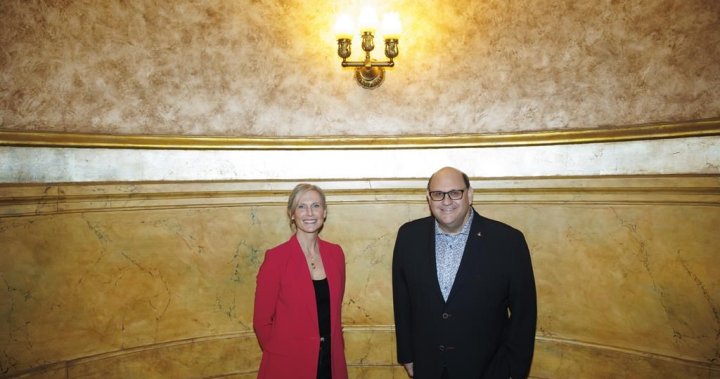New modelling released Wednesday by Ontario’s COVID-19 science advisory table says more than 85 per cent of the eligible population needs to be vaccinated to avoid a lockdown this fall due to the highly contagious delta variant.
The table said Ontarians also need to reduce contacts to about 70 per cent of pre-pandemic levels until vaccination levels are high enough to protect the population. To reduce contacts, the table recommends:
- Reducing indoor density, maintaining physical distancing, limiting large gatherings.
- Continuing indoor mask policies and working from home.
- Implementing policies that accelerate vaccination (e.g. certificates, mandates, outreach).
The table confirmed that Ontario is in the fourth wave of the pandemic and it said its modelling predicts the resulting spike in cases will be “substantial.”
“Vaccination offers substantial protection against severe health outcomes. We do not expect to see the same proportion of severely ill cases in the vaccinated. Among the unvaccinated, we do expect to see a rapid increase in the number of seriously ill people needing hospital care as workplaces and education re-open in September,” the table said.
“The fourth wave will affect all age groups with the potential to exceed ICU capacity.”
The table said if Ontario cannot reduce transmission and accelerate vaccination, the number of people in intensive care units suffering from COVID-19 could exceed that of the third wave by October. You can read the full document for yourself at the bottom of this story.

In its modelling, the table notes that public health measures, together with vaccination, can help to control the fourth wave.
Vaccination will make the difference, it says.
“Unvaccinated people have a 6-fold higher risk of symptomatic COVID-19 disease, a 30-fold higher risk of being in the hospital and 48-fold higher risk of being in the ICU compared to the fully vaccinated,” the table said.
The fourth wave means the province is facing “exponential growth” in cases, said Dr. Peter Juni, the table’s scientific director and a professor of medicine and epidemiology at the University of Toronto.
“What the modelling actually shows is that, if we continue on the general trajectory we were on in August and just believe that we can do all of this now with the current vaccine coverage, this won’t work out,” Juni said on Wednesday.
“We will again be in a situation by October, or so, where our ICUs will start to be challenged more and more.”
Juni said the province needs not only a vaccination rate of 85 per cent or higher, but also some public health restrictions.
“And that’s where now the vaccine certificates that were announced today for Ontario will come in.”
The above 85 per cent coverage is needed in all age groups and all areas of the province, he said.
More than 83 per cent of Ontario residents aged 12 and older had at least one dose of a COVID-19 vaccine as of Wednesday and more than 76 per cent had both doses.

‘Continued vigilance’ needed, province says
Alexandra Hilkene, spokesperson for Ontario Health Minister Christine Elliott, said the pandemic continues to pose challenges for the provincial government.
“There’s no question the months ahead will require continued vigilance as we confront the fourth wave,” Hilkene said in a statement.
Hilkene said the government believes that Ontario is doing better than other jurisdictions because it has kept public health measures in place.
Those measures include indoor masking and capacity limits and its “last mile strategy” to bring vaccine doses to those not yet vaccinated or fully vaccinated.
Dr. Kieran Moore, Ontario’s chief medical officer of health, advised the province to reopen cautiously and, as a result, Ontario has reported one of the lowest rates of active COVID-19 cases at 40 per 100,000, she said. Both B.C. and Alberta have higher active case rates, she added.

“We are confident that Ontario is currently trending between the projected medium- and best-case scenario,” Hikene said.
The province’s new vaccine passport system, revealed earlier in the day, will “further improve” Ontario’s situation, she said.
According to the province, the table’s modelling provides a range of forecasting, from a best- to worst-case scenarios.
“Due to Ontario’s cautious approach and continued adherence to public health measures, we have never experienced the worst-case scenario,” the government said.
Opposition criticizes timing
Liberal Leader Steven Del Duca says the province should have released the modelling earlier in the summer, not the week before schools are set to reopen.
“[Premier] Doug Ford’s strategy of waiting until the very last moment to take action has jeopardized our province’s re-opening,” Del Duca said in a statement.
He said the Ontario Liberals called for mandatory vaccinations for health-care and education workers, vaccine certificates and 10 days of paid sick leave more than a month ago.
NDP Leader Andrea Horwath also said the late release of the modelling is concerning.
“It’s clear now that Doug Ford must use all of the resources of the provincial government to break down barriers and urgently vaccinate every eligible Ontarian,” she said.
“Class sizes must be made smaller so we can reduce contacts to less than 70 per cent of pre-pandemic levels. Doug Ford needs to act now to accelerate vaccine certificate rollout and improve this policy to better protect the most vulnerable among us.”
The modelling comes after Dr. David Fisman, a professor of epidemiology at the University of Toronto’s Dalla Lana School of Public Health, resigned from the table because, he alleged, it delayed publication of its pandemic projections for the fall due to political interference. The table has denied the allegation.
You can read the full projections document below:






More Stories
B.C. mom distributes air quality monitors after 9-year-old’s asthma death during wildfires
What do weight loss drugs mean for a diet industry built on eating less and exercising more?
It could take years to catch up on child vaccinations in Ontario post-pandemic